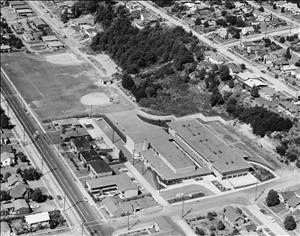This history of Fairmount Park Elementary School is taken from the second edition of Building for Learning: Seattle Public School Histories, which includes histories of every school building used by the district since its formation around 1862. The original essay was written for the 2002 first edition by Nile Thompson and Carolyn J. Marr, and updated for the 2024 edition by HistoryLink contributor Tom G. Heuser.
Rows of Portables
The Fairmount Park neighborhood is said to have been named by a homesick realtor from Philadelphia, after a beautiful area with that name. The school was quickly assembled just off Fauntleroy Way to relieve crowded conditions at the triangle of schools that surround- ed it: Jefferson to the northwest, Gatewood to the southwest, and High Point to the southeast. The adjacent property to the north was acquired by the Seattle Parks Department in 1954. The site of both school and park had been swampy land with alder trees, blackberry bushes, nettles, and mosquitoes – the area previously owned by the Puget Mill Company.
The original Fairmount Park School comprised two rows of portables set up for 248 pupils in grades K-6. At times, students and staff felt like they were pioneers themselves, making do with limited facilities. At first the playfield was not cleared or paved, and offices had to be set up in a classroom. Gradually conditions improved and more portables were erected as enrollment continued to grow, reaching 340 in September 1958. A double portable was brought in to serve as a lunchroom and meeting room.
In the early 1960s, mothers of some pupils appealed to the school board for a permanent facility. Fortunately, funds were available from other district building projects. Over 400 pupils entered the new building when it opened in fall 1964. The functional, light-brick structure with dark-stained woodwork was a welcome sight. Included at the new school were a spacious auditorium/lunchroom and a gymnasium adjacent to the covered play court and the outdoor playfield. When the permanent school opened in 1964, two classrooms were unoccupied, but they were filled by two classes from Alki when an earthquake damaged that school in April 1965. The following September, enrollment exceeded 500 pupils.
Innovative Methods
Several innovative teaching methods were pioneered at Fairmount Park, including divided day and individualized reading programs. In 1973-1974, all 5th graders and some 6th graders participated in Project USE (Urban-Suburban Environment) in which they were paired with classes from Bellevue to study environmental effects on living things. A K-6 math lab was set up in the 1972-1973 school year, and a woodshop class for 6th graders became part of the Career Education Program. Two classes of special education students occupied portables 4 and 5.
Under the district’s desegregation plan, Fairmount Park remained K-5 (from 1978-1981) and K-6 (from 1981-1988).
In his first year at Fairmount Park in 1990-1991, Carl Leatherman was named Principal of the Year by the Elementary School Principals of Washington. One of his trademarks was singing “Happy Birthday” to every child on their birthday. Leatherman served as principal until 1996. Another noteworthy educator at Fairmount was Harlan Jensen, who taught 5th and 6th grade from 1967 until his death in 1999. Jensen was noted for his organization of extracurricular activities including model rocketry, Young Inventors, salmon raising, and more. To honor Jensen’s contributions, Seattle Mayor Paul Schell named March 23, 1998 “Harlan Jensen Day.”
Going into the twenty-first century, one of Fairmount’s focuses was its Success For All Reading Program with an “emphasis on increasing information, literacy, building skills and fostering a love for reading.” Between 2000 and 2002, the school expanded its library collection with $18,000 in new books. Despite these efforts, enrollment at Fairmount Park continued to decline from 250 in 1999 to 169 in 2004. This decline was a part of a broader decline in enrollment across the school district at the time, leading the district to close Fairmount Park after the 2005-2006 school year. When the school closed, it was merged with High Point Elementary School.
When enrollment started to grow after 2009, the district decided to reopen and expand some of its schools. With this funding from two levys, the district hired Miller Hayashi Architects to design a full remodel and 10,550-plus-square-foot, 12-classroom addition for Fairmount Park. Fairmount reopened on September 3, 2014, with an enrollment of 364. Enrollment then peaked at 537 students in 2017.
History
Fairmount Park School
Location: 38th Avenue SW & Brandon Street
Building: Portables
1955: Opened on September 7 as annex to Jefferson
1957: Became independent school
1964: Closed in June
Fairmount Park Elementary School
Location: 3800 SW Findlay Street
Building: Brick
Architect: Carlson, Eley & Grevstad
Site: 3.1 acres
1964: Opened in September
2006: Closed due to declining enrollment
2014: Reopened after remodel and addition (MHA)
Fairmount Park Elementary In 2023
Enrollment: 459
Address: 3800 SW Findlay Street
Nickname: Falcons
Configuration: K-5
Colors: Royal Blue and white

